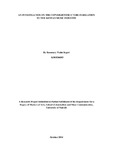| dc.description.abstract | In the traditional African setting, music was viewed as a social tool through which
important societal occasions were marked and valuable lessons passed from one
generation to the next. With time and modernization, the value of music has expanded
to include a strong economic value, with musicians engaging in the art with the hope
of growing a successful business.
The Kenyan music industry has indeed grown in leaps and bounds over the last
couple of years. However, in as much as this is so, many musicians have been unable
to reap the financial benefits of the music industry and earn a meager fraction of what
they are entitled to.
This study investigates the reasons as to why the economic value of the Kenyan music
industry remains virtual, with little to no trickle down to its stakeholders.
It attributes the success or failure of any music industry to the infrastructural layout of
the same, and as such aims to investigate the operations and organization of the pillars
of the Kenyan music industry, and how they interrelate with one another.
Informed by the Game Theory and the Theory of Disruptive Innovation, the study
investigates how decisions made on various levels of authority coupled with the
evolution of technology have played major roles in bringing the Kenyan music
industry to its current state. The study traces back decisions made from colonial times
and a newly independent Kenya by political and industrial leaders, and how such
decisions have subsequently impacted the development of the Kenyan music industry.
It further investigates how technological and telecommunication advancements have
impacted the economic status of the industry, and stakeholders of the same.
The methods employed were qualitative, owing to the exploratory nature of the study.
The findings indicate that indeed, the current infrastructural organizational and
operational layout is not efficient in its functions, much to the detriment of
stakeholders. Relevant suggestions were consequently tabled in a bid to remedy the
current status quo, with the objective of creating a stable environment in which
musicians can conduct their business with a better chance of success. | en_US |

